
table of contents
- Mango varieties
- Growing the mango plant
- Prepare the mango kernel
- Planting mango kernels: instructions
The mango is a popular fruit because of its sweet aroma. The natural range of Mangifera indica extends over the Indian subcontinent and from there it is cultivated in tropical and subtropical regions worldwide. As tasty as the fruits of this species are, the tree, which is increasingly finding its way into European gardens, is appealing. Best of all, you can pull your own from a single mango seed.
Mango varieties
Which mango varieties are suitable?
Before you can plant the mango seed, you should think about the strain you are using. The reason for this is not in the aroma, because mango trees do not develop fruits due to the temperatures in Europe, but rather in the height of their growth. In their homeland and comparable growing areas, the trees reach heights of up to 45 meters and their crowns are up to 30 meters wide, which is too big even for many German gardens. Since the mango has to be kept as a container plant in Germany, such dimensions are of course not feasible, even if the planting would work. On the other hand, rely on the following, small varieties:
- 'Cogshall'
- 'Carrie'
- 'Keit'
- 'Nam Doc Mai'
- 'Palmer'
- 'Irwin'
- 'King Thai'
- ,Sensation'
The two varieties 'Cogshall' and 'Carrie' are the easiest to get in Europe. On average, these varieties reach a height of 2.5 to 3 meters, which makes them ideal for planting in pots. In addition, mango trees can be pruned well, which reduces the height and crown diameter. However, it is not enough to just look for a specific strain as it is equally important where you get it from. Mango kernels from fruits from the classic supermarket can no longer germinate due to the following reasons:
- Antimicrobial treatment
- early harvest and cooling
- long transport routes
The kernels of the mango cannot develop sufficiently in this way, which limits the ability to germinate so much that the fruit is really only suitable for consumption. If you want to grow a mango, you should either buy a fruit in an organic shop or fruit store that is untreated. These fruits are also exposed to the long transport routes, but they are not treated with anti-sprouting agents, which has a positive effect on the ability to germinate. Alternatively, you can buy seeds that have already been prepared in specialist shops or special Internet shops, which in many cases can even be quite cheap.
Tip: the only growing region for mangoes in Europe is in the south of Spain on the Costa del Sol and on the Canary Islands, as there is enough sun here for the sun-hungry trees. This means that if you live in these regions, you can even look forward to fruit-bearing specimens after a waiting period of three to five years.
Growing the mango plant

Prepare the mango kernel
In order to be able to pull a mango out of the mango kernel, you have to prepare it accordingly in order to put it in the mood for germination. The first step is to remove the core from the pulp so that it can be cleaned. Proceed as follows:
- Put on gloves - mango kernels contain substances that are irritating to the skin
- generously cut off the pulp
- You can of course eat it, mix it into a smoothie or use it in some other way
- be careful not to damage the core
- now let the core dry for a while
- then remove the remaining pulp with a brush
- the core should no longer be slippery
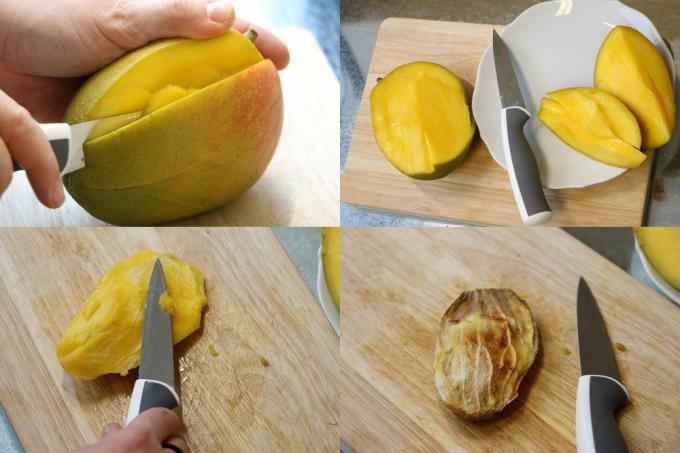
After cleaning, the mango kernel needs to be broken open so that you can get to the seeds that you will end up planting in the soil. All you need is a sharp knife, which you very carefully guide from the tip of the core sleeve over the side and then lever it open. It should now be possible to open the core shell and reveal a seed inside. Its appearance is reminiscent of a flat bean in the following colors:
- Brown
- bright green
- whitish-green
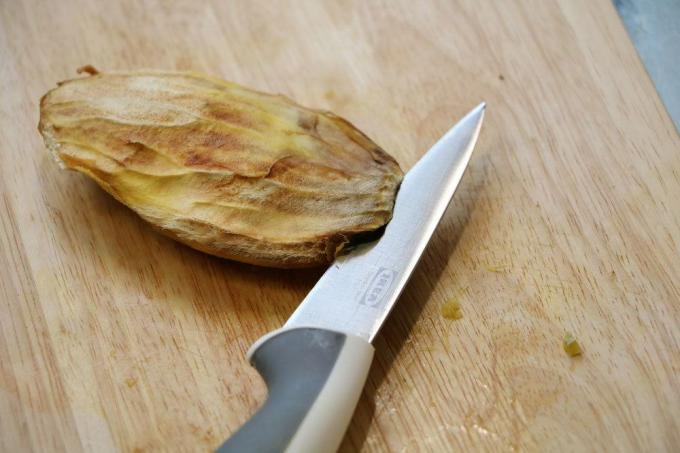
If, on the other hand, the mango kernel is gray in color and also wrinkled, it cannot be used. In this case it is no longer capable of germination and should be disposed of. However, if you find a healthy seed after opening it, use one of the following methods to prepare it for planting:
- Soaking: with this variant you have to subject the mango kernel to a so-called "scarification" process. That is, you either scratch the surface with a knife or rub the core with sandpaper. This wound puts him in a germinative mood. Soak the mango kernel for a period of 24 hours, then take it out of the water and put it in a freezer bag, wrapped in a damp cloth. Now the bag is kept warm for about two weeks. During this time, the first roots develop, followed by a seedling.
- Drying: the core must be completely dry for drying. Then place it on a windowsill or another place that is warm and sunny but not exposed to drafts, otherwise the mango kernel will be too cold. The kernel of the mango remains there for about three weeks. After this time, try to push the core open a little. However, you must not break it in the process, otherwise you cannot plant it. If this is successful, the core can rest for a maximum of one week and is then planted.
Tip: if you don't have a sharp knife to pry open the core, you can use a corkscrew or a sharp tool that doesn't need to be used with pure force. Place this on the tip and drill a small hole through which you can pry open the core sleeve.
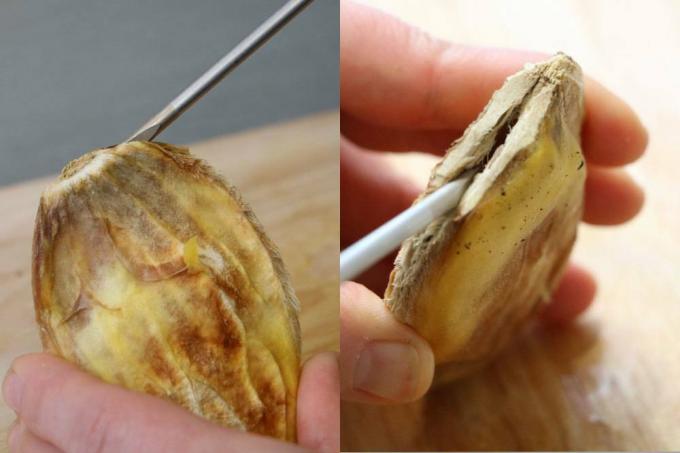
Planting mango kernels: instructions
Compared to preparation, planting the mango kernel is very easy, as the seed will sprout quickly once it is set in substrate. The right pot is important because the mango cannot be planted in the garden in Central Europe. Although adult plants enjoy the sun in the garden over the warm summer months, it would die hopelessly even with winter protection outdoors. For this reason, you should choose a pot that has the following characteristics:
- big enough for the core and the substrate
- small pots are not suitable for planting the mango
- a diameter of 40 cm or more would be ideal
- must have sufficient drainage holes
- heavy materials like clay are better suited
Mangoes do not tolerate waterlogging and for this reason a single drainage hole is not enough. You should therefore use pots that have several drainage holes, because even the mango kernel is sensitive to excessive moisture after planting. Choose one of the following substrates for growing the tropical plant:
- Potted plant soil, sand, some compost (ripe)
- Potting soil, some compost (ripe)
- Coconut fiber, some compost (ripe)
If you are Potted plants- or use potting soil, you must sterilize it. This means that you rid the soil in which you want to grow the mango kernel of harmful bacteria, viruses, microorganisms and insect larvae that could endanger the health of the mango. There are two ways of doing this:
- Heat in the oven for 15 minutes at a temperature of at least 160 ° C
- Treat in the microwave on a high setting for a short time
When growing the mango kernels in coconut fibers, this treatment is not necessary and you can start planting the mango kernel immediately after the substrate has been provided. Remember: put on gloves while planting the mango kernel so your skin doesn't get unnecessarily irritated.
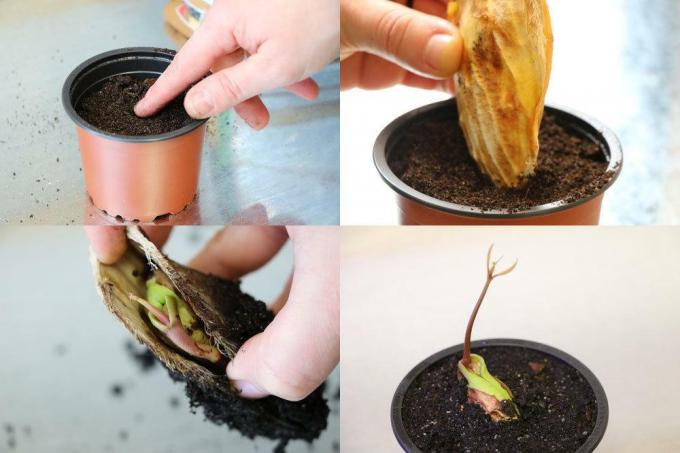
The instructions in detail:
- First, fill the bottom of the flower pot with one Drainage layer. Pottery shards and gravel are best for this, even larger stones are suitable for this. The layer does not have to be high, it just helps the water to drain off better and not to build up.
- Now fill the entire pot with the chosen substrate. It should be a Distance to the edge of at least three centimeters must be preserved so that the substrate is not accidentally washed out of the pot during watering.
- Before you put the seed in the substrate, double-check the health and roots. If this has started to go moldy despite the preparation, you can no longer put it in the ground, as this mango kernel is no longer capable of germination.
- Now stick the mango kernel upright in the ground. He should be about stick out two to three centimeters from the groundto get enough light. This step only applies to kernels that have been dried.
- If the seedling has already loosened from the seed of the mango, you must not stick it in the substrate, otherwise it will be damaged. You have to carefully plant this 20 centimeters deep in the ground with the roots down so that some of the leaves peek out from above. This step only applies to kernels that have been soaked.
- After planting, the mango kernel needs between four and six weeksuntil it grows into a small seedling. The planted seedling, on the other hand, grows into a small tree during this time. Both variants require a constant temperature of during drawing 25 ° C to 30 ° C and must be kept moist, but not wet, at all times. A high level of humidity should be aimed for during this time.
- After the Mango tree has rooted through the pot, repot.
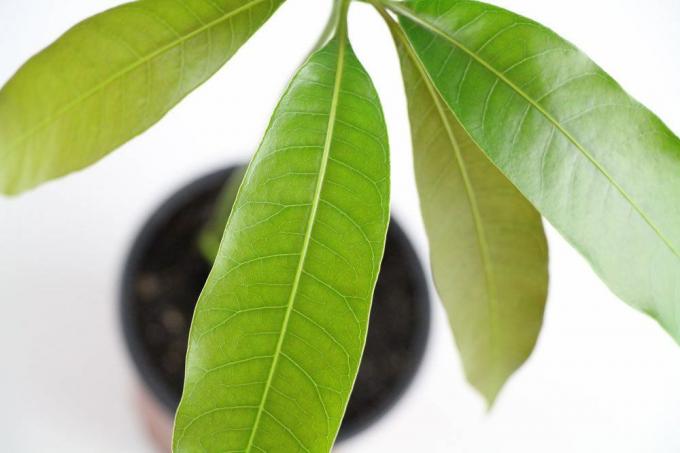
Tip: it can be helpful to place the mango on a roll coaster. Since Mangifera indica can become quite heavy within a short period of time, you do not have to use a lot of force to find the ideal location over the year, because mangoes like to follow the sun.


